
The Reclamation Act of 1902 is a United States federal law that funded irrigation projects for the arid lands of 17 states in the American West.
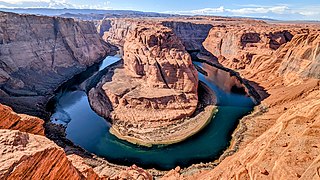
The Colorado River is one of the principal rivers in the Southwestern United States and in northern Mexico. The 1,450-mile-long (2,330 km) river, the 5th longest in the United States, drains an expansive, arid watershed that encompasses parts of seven U.S. states and two Mexican states. The name Colorado derives from the Spanish language for "colored reddish" due to its heavy silt load. Starting in the central Rocky Mountains of Colorado, it flows generally southwest across the Colorado Plateau and through the Grand Canyon before reaching Lake Mead on the Arizona–Nevada border, where it turns south toward the international border. After entering Mexico, the Colorado approaches the mostly dry Colorado River Delta at the tip of the Gulf of California between Baja California and Sonora.
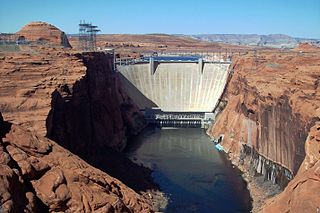
Glen Canyon Dam is a concrete arch-gravity dam in the southwestern United States, located on the Colorado River in northern Arizona, near the city of Page. The 710-foot-high (220 m) dam was built by the Bureau of Reclamation (USBR) from 1956 to 1966 and forms Lake Powell, one of the largest man-made reservoirs in the U.S. with a capacity of more than 25 million acre-feet (31 km3). The dam is named for Glen Canyon, a series of deep sandstone gorges now flooded by the reservoir; Lake Powell is named for John Wesley Powell, who in 1869 led the first expedition to traverse the Colorado River's Grand Canyon by boat.
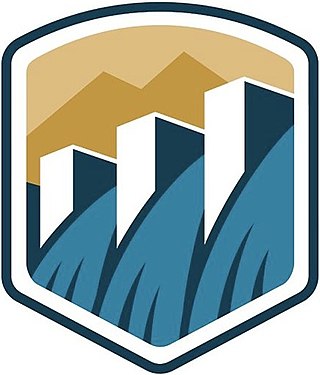
The Bureau of Reclamation, formerly the United States Reclamation Service, is a federal agency under the U.S. Department of the Interior, which oversees water resource management, specifically as it applies to the oversight and operation of the diversion, delivery, and storage projects that it has built throughout the western United States for irrigation, water supply, and attendant hydroelectric power generation. It is currently the U.S.'s largest wholesaler of water, bringing water to more than 31 million people, and providing one in five Western farmers with irrigation water for 10 million acres of farmland, which produce 60% of the nation's vegetables and 25% of its fruits and nuts. The Bureau is also the second largest producer of hydroelectric power in the western U.S.

The Teton Dam was an earthen dam in the western United States, on the Teton River in eastern Idaho. It was built by the U.S. Bureau of Reclamation, one of eight federal agencies authorized to construct dams. Located between Fremont and Madison counties, it suffered a catastrophic failure on June 5, 1976, as it was filling for the first time.

Floyd Elgin Dominy was appointed commissioner of the United States Bureau of Reclamation from May 1, 1959, to December 1, 1969, by Dwight D. Eisenhower. Dominy joined the Bureau in 1946. He was the assistant commissioner from 1957 to 1958. He was responsible for building Glen Canyon Dam and the creation of Lake Powell behind it. He died in Boyce, Virginia, where he had lived since at least 1990.

The San Juan River is a major tributary of the Colorado River in the Southwestern United States, providing the chief drainage for the Four Corners region of Colorado, New Mexico, Utah, and Arizona. Originating as snowmelt in the San Juan Mountains of Colorado, it flows 383 miles (616 km) through the deserts of northern New Mexico and southeastern Utah to join the Colorado River at Glen Canyon.
Marc Reisner was an American environmentalist and writer best known for his book Cadillac Desert, a history of water management in the American West.
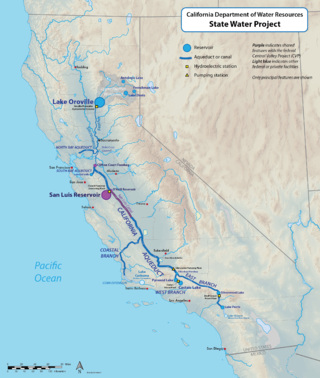
The California State Water Project, commonly known as the SWP, is a state water management project in the U.S. state of California under the supervision of the California Department of Water Resources. The SWP is one of the largest public water and power utilities in the world, providing drinking water for more than 27 million people and generating an average of 6,500 GWh of hydroelectricity annually. However, as it is the largest single consumer of power in the state itself, it has a net usage of 5,100 GWh.

Fontenelle Reservoir is an artificial reservoir located in southwest Wyoming. It lies almost entirely within Lincoln County, although the east end of the Fontenelle Dam and a tiny portion of the reservoir are actually in northwestern Sweetwater County. Impounded by Fontenelle Dam, the reservoir acts primarily as a storage reservoir for the U.S. Bureau of Reclamation's Colorado River Storage Project, retaining Wyoming water in the state as a means of asserting Wyoming's water rights, with a secondary purpose of power generation. Water from Fontenelle Reservoir is used in local industries such as mining and power generation. Although initially projected to provide irrigation water for agriculture, the irrigation component was downgraded after difficulties with efficient irrigation in Wyoming's high semi-desert became apparent.

Ah Pah Dam was a proposed dam on the Klamath River in the U.S. state of California proposed by the United States Bureau of Reclamation as part of its United Western Investigation study in 1951. It was to have been 813 feet (248 m) high and was to be located 12 miles (19 km) upstream of the river's mouth. It would have been taller than any existing dam in the United States and it would stand almost as tall as the Transamerica Pyramid building in San Francisco, but would have been much more massive. It would have flooded 40 miles (64 km) of the Trinity River, including the Yurok, Karuk and Hupa Indian Reservations, the lower Salmon River, and 70 miles (110 km) of the Klamath River, creating a reservoir with a volume of 15,000,000 acre-feet (19 km3) – three fifths the size of Lake Mead, and over three times the size of the current largest reservoir in California, Shasta Lake. The water would flow by gravity through a tunnel 60 miles (97 km) long to the Sacramento River just above Redding and onward to Southern California, in an extreme diversion plan known as the Klamath Diversion. The tunnel would have been located near the southernmost extent of the reservoir. It was named in the language of the Yurok people.

Cadillac Desert: Water and the Transformation of Nature is a 1997 American four-part documentary series about water, money, politics, and the transformation of nature. The film was directed by Jon H. Else and Linda Harrar.
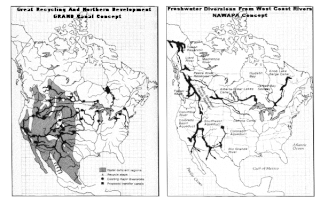
The North American Water and Power Alliance was a proposed continental water management scheme conceived in the 1950s by the US Army Corps of Engineers. The planners envisioned diverting water from some rivers in Alaska south through Canada via the Rocky Mountain Trench and other routes to the US and would involve 369 separate construction projects. The water would enter the US in northern Montana. There it would be diverted to the headwaters of rivers such as the Colorado River and the Yellowstone River. Implementation of NAWAPA has not been seriously considered since the 1970s, due to the array of environmental, economic and diplomatic issues raised by the proposal. Western historian William deBuys wrote that "NAWAPA died a victim of its own grandiosity."

Fontenelle Dam was built between 1961 and 1964 on the Green River in southwestern Wyoming. The 139-foot (42 m) high zoned earthfill dam impounds the 345,360-acre-foot (0.42600 km3) Fontenelle Reservoir. The dam and reservoir are the central features of the Seedskadee Project of the U.S. Bureau of Reclamation, which manages the Fontenelle impoundment primarily as a storage reservoir for the Colorado River Storage Project. The dam suffered a significant failure in 1965, when the dam's right abutment developed a leak. Emergency releases from the dam flooded downstream properties, but repairs to the dam were successful. However, in 1983 the dam was rated "poor" under Safety Evaluation of Existing Dams (SEED) criteria, due to continuing seepage, leading to an emergency drawdown. A concrete diaphragm wall was built through the core of the dam to stop leakage.

The Klamath Diversion was a federal water project proposed by the U.S. Bureau of Reclamation in the 1950s. It would have diverted the Klamath River in Northern California to the more arid central and southern parts of that state. It would relieve irrigation water demand and groundwater overdraft in the Central Valley and boost the water supply for Southern California. Through the latter it would allow for other Southwestern states—Arizona, Nevada, New Mexico and Utah—as well as Mexico to receive an increased share of the waters of the Colorado River.
The Western Waters Digital Library (WWDL) provides free public access to digital collections of significant primary and secondary resources on water in the western United States. These collections have been made available by research libraries other academic and institutional partners.
Hooker Dam was a proposed dam on the Gila River in New Mexico, planned as a major component of the Central Arizona Project. Located near the mouth of the river's canyon upstream from the confluence of the Gila with Mogollon Creek and below Turkey Creek, the dam was to be part of the CAP's Gila River Division, authorized under the 1968 Colorado River Basin Project Act. The project was planned to provide 18,000 acre-feet (0.022 km3)/year of water to western New Mexico.
The Seedskadee Project is a water resources development project of the U.S. Bureau of Reclamation. The project focuses on the upper Green River in western Wyoming, storing the river's waters in Fontenelle Reservoir. The project is associated with the Colorado River Storage Project, retaining the waters of the Green for use in the upper Colorado Basin. Water held behind Fontenelle Dam, built from 1961 to 1968, is used for hydroelectric power generation and industrial use. The reservoir supports recreational use.

Claire Vaye Watkins is an American author and academic.

Gold Fame Citrus is a 2015 speculative fiction novel by Claire Vaye Watkins. It is her second book, but her first novel. The work received positive reviews.















